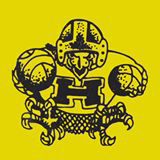 On 1938’s Thanksgiving afternoon, Donald Waters, an HHS school student who lived across the street from me, took me to see the Hens play Holdenville. I was just eight, and it was the first football game I ever attended. It was the final Hen game of the season, and they beat Holdenville 50-6 to make their season record 2 wins and 7 losses. (With that kind of Hen record, Holdenville must have been terrible to lose that badly to the Hens.) But even with the terrible Hen record, they outscored their opponents for the full season 110 to 88.
On 1938’s Thanksgiving afternoon, Donald Waters, an HHS school student who lived across the street from me, took me to see the Hens play Holdenville. I was just eight, and it was the first football game I ever attended. It was the final Hen game of the season, and they beat Holdenville 50-6 to make their season record 2 wins and 7 losses. (With that kind of Hen record, Holdenville must have been terrible to lose that badly to the Hens.) But even with the terrible Hen record, they outscored their opponents for the full season 110 to 88. The star Hen running back that day, and for the season, was Roy Van Meter, the first of the long string of Van Meters to play for the Hens. There might have been something fishy about his playing for the Hens, though. He played for them in 1937 and 1938 after moving to Henryetta from some town in eastern Oklahoma, maybe Stigler. A few years before Cecil Van Meter died, he told me that after Roy played high school football in the earlier town for three or four years, his father was given a coal mining job in those depression years so Roy could play for the Hens, even though he was no longer eligible, and the Hens had to hold him out of the 1938 McAlester game because he had played against them three times for the earlier town and in 1937 for Henryetta.
Years later, at Henryetta’s 2000 all-school reunion, a tent was set up lunch at Nichols Park and I sat across the table from Roy and his wife, who were attending from their home in Detroit. Naturally, I told him I had seen him play. According to his Detroit obituary a few years later, he was called “The Tractor” and was a practically unbeatable arm wrestler.
The rest of the games discussed here took place when Marion Anglin was the coach. Before moving to Henryetta, Anglin had a 36-3 record at Pawhuska. In those depression years, there were a few post season high school games to raise money for charitable purposes, and in 1939, Anglin’s Pawhuska Huskies beat the Miami Oklahoma Ironmen 25--0 in a post season game. (In 1937, the Hens only loss (12-0) was in one of those games played at Perry.)
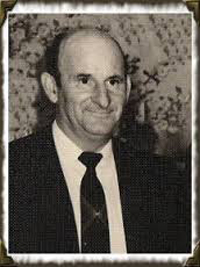 In appreciation for Pawhuska’s win Miami, Pawhuska boosters sent Anglin and his wife, Pauline, to that year’s Sugar Bowl. Then Anglin accepted the coaching job at Henryetta. I knew Marion Anglin, as well Mrs. Anglin, and their children, Eddie and Nancy, very well from 1940 until I graduated from HHS in 1948. I was Mr. Anglin’s football student manager in 1945, but before that, from my sixth through ninth grade years Mr. Anglin took me with his wife to basketball games where we sat behind the desk where Jack Gibson announced the games.
In appreciation for Pawhuska’s win Miami, Pawhuska boosters sent Anglin and his wife, Pauline, to that year’s Sugar Bowl. Then Anglin accepted the coaching job at Henryetta. I knew Marion Anglin, as well Mrs. Anglin, and their children, Eddie and Nancy, very well from 1940 until I graduated from HHS in 1948. I was Mr. Anglin’s football student manager in 1945, but before that, from my sixth through ninth grade years Mr. Anglin took me with his wife to basketball games where we sat behind the desk where Jack Gibson announced the games. My older sister, Betty, was a baby sitter for the Anglins during those years and on endless other occasions, and when the coach picked Betty up to baby sit, he also picked me up so I could go to the game with Mrs. Anglin. Betty also helped Mrs. Anglin with household chores from the time they moved to Henryetta until Betty graduated from HHS in 1944. My younger sister, Dora, then took over the baby sitting, but got a friend to help with the housework. Through my junior high years, I spent a lot of after basketball game time at the Anglin house at Fifth and Gentry and even got to meet several basketball officials when they went there after games to have coffee and a desert. You read that right. Mr. Anglin liked to be friends of the officials. I still remember that one official was named Zeke Burton, who also officiated football games, was an official at the Sugar Bowl at least once, and maybe more.
The first Anglin-coached game to mention was the 1940 Ada game in Henryetta. I didn’t know the details at the time, and I wasn’t at the game, though it was in Henryetta and I attended several games that year. It was Anglin’s first year as the Hen coach – their record for the year was 5 wins, 4 losses and 1 ties. The details about the Ada game came to me from John Greiner, a 1960 HHS grad who had a career with the Daily Oklahoma and has access to its archives.
The game was a story of how, in just two plays, what appeared to be a locked up win could turn into what would go into the records as a what appeared to be a convincing loss. The Hens led the Cougars 14-12 with just a minute to play and had the ball at the Cougar one or two yard line. Field goals by high school teams were practically unheard of then, so the thing to do was to try to score a touchdown. The Hens threw a pass that was intercepted and returned all the way for an Ada touchdown. Ada didn’t make the extra point, so they just led 18-14 with most of a minute to play, so the Hens still had a small chance to win. Well, Ada kicked off, and George Xezonatas, our star running back (his father owned the long ago Purity Café at Fifth and Main) forgot that, unlike punts that could just be ignored and taken out to the 20 if the ball died in the end zone, the rule back then was that the kickoff ball was a live ball and could be claimed by anybody once it had travelled the required distance – even if it was in the endzone.
George just ignored it, as he could have a punt, and a Cougar covered it for another Ada touchdown – the game was a 24-14 Ada win of a game that appeared to be a sure Hen win before those two plays. George Xezonatas was also the Hen punter and in the Seminole game that the Hens lost 20-0 in Henryetta that year, and one of his punts went straight up in the air and when it came down at about the Hen 30, a Chieftain ran it into the touchdown. I remember the punt, but not that it resulted in a Chieftain touchdown until John Greiner told me.
The next game to mention is the 1944 game in Henryetta with the Oklahoma University Junior Varsity. Why the Hens were playing the OU JV needs explanation. In WWII, many service men were sent to various colleges around the country for some kind of specialized training, and practically every college had service men on campus. I even recall that many service men who were attending East Central State College had a lot of fun in the stands during our 1943 24-0 win at Ada. During the war, the rule was that these service men were eligible to play for the college team, even if their eligibility had expired and even if they had played professional football. (With this rule, a man in the service could even find himself playing against his former alma mater – as was the case when Elroy, “Crazy Legs” Hirsh, a great running back was very instrumental in a wartime Michigan win over his alma mater - Wisconsin.)
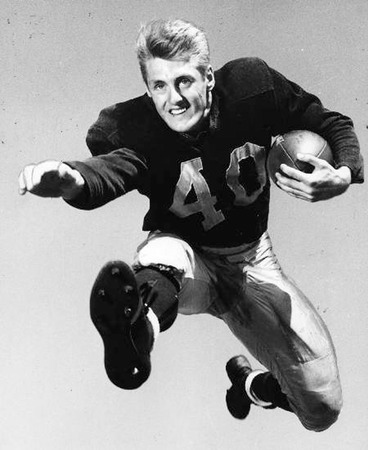
With all the service men in colleges and eligible to play for the college teams, it was very difficult for college-age players just out of high school to make college teams. So most young players who had not yet gone into a service branch, played on college junior varsity teams. In 1943, the OU junior varsity had a very good team, but it was possible for an outstanding Oklahoma high school team to beat them. And the Hens were outstanding in both 1942 and 1943. The 1942 Hens were undefeated, allowed their ten opponents just 26 points, and were named the consensus state champion by the Tulsa World. (Oklahoma’s first playoffs were in 1944.) In 1943, they allowed only 32 points, but 19 of them were in their only loss, which was at Tulsa Webster when the Hens had two touchdowns call back. Webster was the World’s 1943 consensus state champions, and when they were named that, the Webster coach said he was glad the playoffs weren’t starting until 1944, because he wouldn’t want to have to play the Hens again.
So with a 19-1 record over two years, and their only loss being questionable, the Hens scheduled the OU Junior Varsity for the fourth game of 1944. Then, in August, 1944, the old Big Six Conference (Oklahoma, Kansas, Kansas State, Iowa State Nebraska and Missouri) announced that service men in its schools would no longer be eligible to play for the school’s varsity. So the regular recent high school graduates became the varsity players and the OU Junior Varsity that the Hens would be playing would be comprised of players who had already played college football, and some even had pro football experience. When the OU Junior Varsity team came to town, the Hens had won 22 of their last 23 games, had outscored their opponents 629 to 58 in those games, and had shut out their last seven opponents. The Hens lost 27-0.
Three weeks later, the Hens played Ada in Henryetta. 1944 was the first football playoff year and it was expected that our conference (district) champion would be either the Hens or Ada. Midway in the second quarter of the Ada game in Henryetta, the left shoulder of our quarterback, Grover Bynum, was broken and he played the rest of the game with a broken shoulder instead of letting anyone know his condition. (I think Grover was the best quarterback the Hens had during Anglin’s years.) Ada had a very good team, and might have beaten the Hens anyway, but without a capable Grover, the Cougars beat the Hens 19-0.
The next week, the Hens played Holdenville Holdenville in Henryetta. Their brand new quarterback, Billy Thomas, a junior, became a good quarterback in his senior year, but he had little effect on the 1944 Holdenville game. Since the Hens didn’t have Bynum at quarterback, they got off to a slow start and trailed 6-0 at the half. Holdenville scored again in the third quarter to take a 13-0 lead, and the Hens scored early in the fourth to make it 13-6 for the Wolverines. The Holdenville return of the following kickoff was to the 50 yard line, the Hens were flagged unnecessary roughness, which would mean a 15 yard penalty to the Hen 35. I was in the band that year and sat on an end of the first row of the band down in front of the grandstand. Suddenly a man ran past me and onto the field where he slugged the official who threw the flag.
I won’t mention his name here, but he was an uncle of one of my two best friends and was also a somewhat older brother of a good junior Hen lineman who didn’t play on kickoffs. That lineman, who immediately realized it was his older brother, and coach Anglin, ran onto the field and drug the attacker off. He’d had too much drink, and I think some police in the stands took him to jail. Regardless, the Hens were penalized another 15 yards to the Hen 20 for “illegal participation,” and in a few plays, Holdenville scored to make it 20-6 with about 10 minutes to go. So the Hens were back to 13 down. They then scored to make it 19-13, but failed to make ground on their next possession, so Holdenville got the ball leading 19-13 with about five minutes to go. The Hens stopped them, got the ball back, and on a fourth down in the last minute, one Van Meter threw a completion to another Van Meter, who scored. (It was probably John to Clifford, but could have been the reverse.) The point was good and the Hens won 20-19.
I had a Free-Lance route, and the morning after the game, while going around collecting from customers, I stopped to buy a coke and spend time talking with a classmate, Don McRight, at the long ago McRight filling station that was diagonally southeast of the old Washington grade school. I saw a Hen schedule posted in the window with scores on it, and it showed that the Hens had lost 19-13. Don had given up and left early. It wasn’t easy to convince him that we had won 20-19.
This is getting long and some readers could well have had enough by now, but I must mention games with our biggest rival, the Okmulgee Bulldogs. Before Anglin was our coach, they had a distinct all-time winning record against the Hens, and usually dominated them. In Anglin’s first two years, 1940 and 1941, they beat the Hens 35-0 in Henryetta and 19-0 in Okmulgee. Then came the Hen’s two greatest years, that have already been mentioned in the discussion about the OU Junior Varsity game. The undefeated 1942 Hens beat the Bulldogs in Henryetta, but just 8-0 when I saw the scoring of the first safety I had ever seen. Then, in 1943, the Hens didn’t just beat them, they slaughtered them.
Wartime travel was limited, so it wasn’t unusual for games with distant opponents to be replaced by having home and home games with a nearby opponent. The Hens won 26-0 in Okmulgee in 1943 and then 48-0 in Henryetta to have a combined win total of 74-0. 1945 was the year I was the Hen student manager, so I naturally remember the game in Okmulgee when it was a practical certainty that the Hens would win - probably by a large margin. Well, Okmulgee scored first, but that was the end of their enjoyment. The Hens won 40-7.
But I must mention what happened after the last touchdown. We had an outstanding left end named Walter Morris (he was also an outstanding basketball player and was an all-state forward). All fall, he had stayed after on the field after practice to learn to kick an extra point by a drop-kick. That was something from the football’s early days when they didn’t have a holder to place the ball for the kicker.
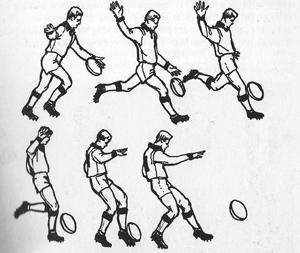 The ball was snapped directly to the kicker, who then dropped it so it would bounce, and he then kicked it on the bounce.
The ball was snapped directly to the kicker, who then dropped it so it would bounce, and he then kicked it on the bounce. All season, Walter had asked coach Anglin to let him drop-kick an extra point, so after the last touchdown at Okmulgee, before Walter even asked, Anglin told him to drop-kick the try. Walter caught the snap from center and dropped the ball as was required, but it bounced to the side and his kicking foot didn’t even touch it That ended Walter’s drop-kick career.
Now I will jump forward to the 1947 (my senior year) game in Okmulgee. The Bulldogs had an outstanding team that ran a double-wing formation that was definitely a “four yards and a cloud of dust” offense.
Without going through the details, they were in control and had the ball practically the whole game and the Hens ran very few plays. The Hens had the ball just three plays in the second quarter, but in those three plays, with excellent performances by Vernon Van Meter and Benny Leonard, they gained over 90 yards to a touchdown and a 7-0 lead. The Hens then had the ball just one play in the third quarter when they gained possession near their own goal line, and punted out of danger on that play.
The Hens won the game 7-0, but Okmulgee went on to beat Frederick 14-6 in the state championship game played at Oklahoma City’s Taft Stadium or at Norman at a time when OU’s stadium seated just 36,000. The Hens had a decent team and ended the season 6-2-1, but didn’t make the playoffs. Still, he Hens beat Okmulgee’s state champion team 7-0.
Back to the 1942 consensus state champion Hens. Besides being the consensus state champs, something else was different about the1942 Hens – the stars of that team were not named Van Meter. Cecil would have been a junior, John a sophomore, and Clifford a freshman, but the two stars in1942 were brothers, Mason and Doyle Fritz. Mason was a running back and Doyle was an end. They had played in 1940 for Weleetka, and then moved to Henryetta, where the Hens beat Weleetka 20-0 in the opening game. It was suggested to me many years later that there was some skullduggery involved the Fritz family move from Weleetka. The Fritz’s little brother, Doug, was a Washington school classmate. and friend of mine in 1941 and then in junior high in 1942. I rode to 1941’s final game with the Mr. and Mrs. Fritz and Doug. The Hens lost to Durant 18-13 after Mason was hurt and taken to the hospital, so after the game, I rode with them to the hospital. I think Mason was kept at least overnight, and we were there so long that it was probably one a. m. when the Fritz’s took me home. I don’t know what happened to Mason, Doyle, Doug, or their parents after Doug and I were in the seventh grade in 1942/3. Mason and Doyle probably went into the service, and the parents, with Doug, might have headed to California where so many plants made war material.
In 1947, my senior year, the Hens lost 6-0 in an early season game to Wewoka’s Tigers at Wewoka, and Wewoka led the district all through the season, but the Hens still had a chance to win it after Wewoka lost to Seminole. But when we played Holdenville, the Hen’s starting center wasn’t there because his wife was having a baby back in Henryetta (even though he was still just a junior). Still, the Hens led 13-7 late in the game.
Then, on a Holdenville desperation fourth down, the Hens stopped the ball carrier short of a first down at about the Hen 40 yard line, but then all the Hens fell off of him for some reason and he ran to the goal line for a 14-13 Holdenville win. That ended the Hen playoff chances. Wewoka then tied Okmulgee, but lost to them on penetrations in a first round playoff game, as Okmulgee moved on to become the state champion team in a season when the Hens beat them.
I suppose I should at least mention the not so good 1946 Hens of my junior year. The very strong 1945 Hens when I was student manager started 10 seniors and 1 freshman – Vernon Van Meter. So except for Vernon, the 1946 Hens had little experience. Their record was 4 wins, 3 losses and 2 ties, and they even surprisingly lost 7-6 to Okmulgee. They also lost to Wewoka 7-0 and were then hammered 27-7 at Durant. The ties were both 7-7 - one with Edmond, which was then a smaller class school, and the other with Holdenville.
I suppose the best that can be remembered about the 1946 Hens is that they provided good experience for the better 1947 Hens, who, I repeat, beat Okmulgee in the season when Okmulgee won the state championship.
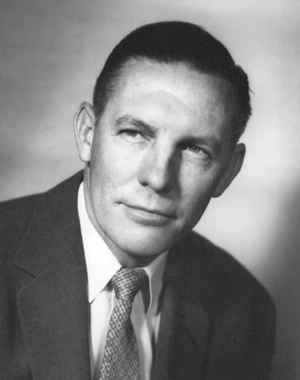 Tony Anderson became the HHS band director in the fall of 1916. Before he arrived there were 48 members in the marching band, including junior high students. Within two years, Anderson increased the number to 80 in the separate junior high band and 96 in the high school band – and the sizes kept increasing as he immediately started doing great things with the band. As time went on, the HHS band won the state marching contest for so many consecutive years that, I think in 1959, they were allowed to give an exhibition marching performance at the state marching contest, but were not allowed to compete for the championship.
Tony Anderson became the HHS band director in the fall of 1916. Before he arrived there were 48 members in the marching band, including junior high students. Within two years, Anderson increased the number to 80 in the separate junior high band and 96 in the high school band – and the sizes kept increasing as he immediately started doing great things with the band. As time went on, the HHS band won the state marching contest for so many consecutive years that, I think in 1959, they were allowed to give an exhibition marching performance at the state marching contest, but were not allowed to compete for the championship. The band was in the 1956 Rose Parade, in one or more Mardi-Gras parades, and also marched in the snow in the John F. Kennedy inauguration parade. Then, the Oklahoma State Board of Education issued instituted a rule that limited the number of days anyone could be out of school for extra-curricular activities and still have them recorded as excused absences.
From the outset Anderson’s great band began attracting boys who would have gone out for football to join the band. The 1948 and 1949 Hen football seasons were Anderson’s third and fourth years, and with the band gaining members, the Hen records in those two years were 3-7-0 and 1-8-1. So Anglin was replaced as the Hen football coach, but he stayed several more years as basketball coach.
Anglin’s replacement, a man named Berryhill, had several poor teams in the 50s, probably also due to at least some extent by the great success of Tony Anderson. Anglin was a great coach and Anderson was a great band director. I guess HHS just wasn’t large enough to have a great football team and a great band at the same time.
I thank those who have read this to the end, and understand why others gave up along the way.
















